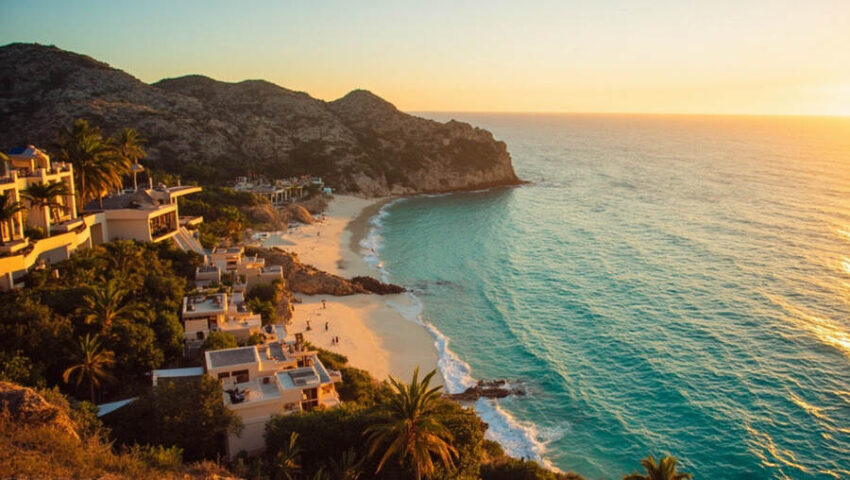Published on
November 7, 2025

Los Cabos joins Cancún, La Romana, and Holbox in offering a new standard of luxury travel that focuses not only on indulgence but also on sustainability, personal wellness, and meaningful cultural connections. This shift in luxury tourism reflects a growing demand from travellers who seek more than just opulence; they desire transformative experiences that enrich their well-being and support the preservation of the destinations they visit. From wellness retreats and eco-friendly resorts to immersive cultural experiences, these destinations are leading the charge in conscious luxury, reshaping what it means to travel in style and purpose. By prioritising sustainable practices, wellness-focused amenities, and authentic cultural engagement, they are setting a new benchmark for what high-end travel should be in the 21st century.
From wellness retreats in the deserts of Baja California to the tranquil shores of Holbox, the Americas are becoming home to destinations that combine high-end comforts with a focus on ethical travel. These regions offer travellers not just relaxation, but an opportunity to connect with nature, support local communities, and embark on transformative journeys.
Los Cabos: Wellness at the Intersection of Luxury and Nature
Los Cabos, on Mexico’s Baja California Sur peninsula, has long been a haven for the affluent, with its dramatic desert landscapes meeting the waters of the Sea of Cortez. Today, it stands as a beacon of wellness tourism, where travellers seek more than just indulgence—they seek renewal and restoration.
The resorts here have evolved beyond traditional spa treatments, now offering comprehensive wellness retreats that combine ancient Mexican healing practices with modern therapies. These destinations offer personalised health programs, yoga sessions, and even longevity retreats designed to promote mental and physical well-being.
The region’s culinary scene is also part of its conscious luxury shift. Baja Med cuisine, a fusion of Mediterranean and Pacific influences, has emerged as a star attraction. Los Cabos has become a culinary hub, where guests savour dishes made from fresh, locally sourced ingredients—many from nearby farms or the waters just off the coast. This focus on farm-to-table dining not only enhances the experience but also supports sustainable agricultural practices and promotes a deeper connection to the land and sea.
La Romana: A Fusion of Privacy, Culture, and Luxury
In the Dominican Republic, La Romana offers an exclusive alternative to the bustling tourist hotspots like Punta Cana. While known for the Casa de Campo resort, La Romana has embraced a luxury model that blends privacy, cultural preservation, and residential exclusivity.
The region has also become known for its commitment to cultural engagement, particularly through the Altos de Chavón complex—a recreation of a 16th-century Mediterranean village that houses a design school and art galleries. Here, high-end visitors can immerse themselves in the local culture, supporting Dominican artists and learning about the country’s rich artistic heritage. This blend of luxury and cultural preservation reflects the growing desire among travellers for experiences that go beyond mere relaxation to encompass learning, patronage, and connection with the local community.
Cancún: Luxury Meets Sustainability in the All-Inclusive Model
Cancún, once famous for its “party scene” and sprawling all-inclusive resorts, is now embracing a new era of luxury tourism. The city is redefining the all-inclusive experience with a greater focus on sustainability and premium services.
High-end resorts in Cancún are reinventing the traditional all-inclusive model by offering wellness-focused amenities, personalised services such as butlers and wellness concierges, and sustainable architecture that incorporates eco-friendly materials and energy-efficient systems. Many resorts are also striving for environmental certifications and reducing their carbon footprint by eliminating single-use plastics and embracing greener building practices.
Cancún has proven that it’s possible to blend mass appeal with sustainable luxury, showing that travellers seeking an indulgent experience can still make ethical choices that support environmental and local community welfare.
Holbox: Slow Travel and a Return to Nature
In stark contrast to Cancún’s vibrant tourism scene, Holbox island represents the essence of slow luxury. Located off the northern coast of Mexico’s Yucatán Peninsula, Holbox is the ideal destination for those seeking a slower pace of life, away from the noise and crowds of mainstream tourist areas.
The island has no cars, and its simple, sustainable boutique hotels are a testament to conscious travel. Here, luxury is characterised by the absence of excess—no high-rise hotels, no commercialisation, just peaceful surroundings and an unspoiled natural environment.
Holbox’s most famous attraction—swimming with whale sharks—is a perfect example of how conscious luxury can provide a thrilling yet eco-friendly experience. This carefully regulated activity allows travellers to observe these gentle giants in their natural habitat while contributing to the conservation of the species and the environment. Holbox offers an ideal retreat for those who seek solitude and a chance to reconnect with nature, providing a much-needed escape from modern-day distractions.
The Future of Luxury Travel: Consciousness Over Excess
The luxury travel industry in the Americas is at a turning point. Destinations like Los Cabos, La Romana, Cancún, and Holbox are redefining what it means to travel in style. The modern luxury traveller is no longer satisfied with simply escaping to lavish resorts. Instead, they seek destinations that offer more than just indulgence—they want to engage with nature, support local communities, and immerse themselves in culture.
As travellers demand more sustainable, authentic, and transformative experiences, destinations that embrace conscious luxury will continue to thrive. The future of premium travel is no longer about excess; it’s about meaningful connections, responsible experiences, and a commitment to preserving the world’s most precious resources.
Conclusion: Conscious luxury is shaping the future of travel in the Americas. From wellness retreats in Los Cabos to cultural immersion in La Romana, these destinations are proving that luxury can be both indulgent and responsible. The next generation of luxury travellers values experiences that are authentic, sustainable, and transformational.



